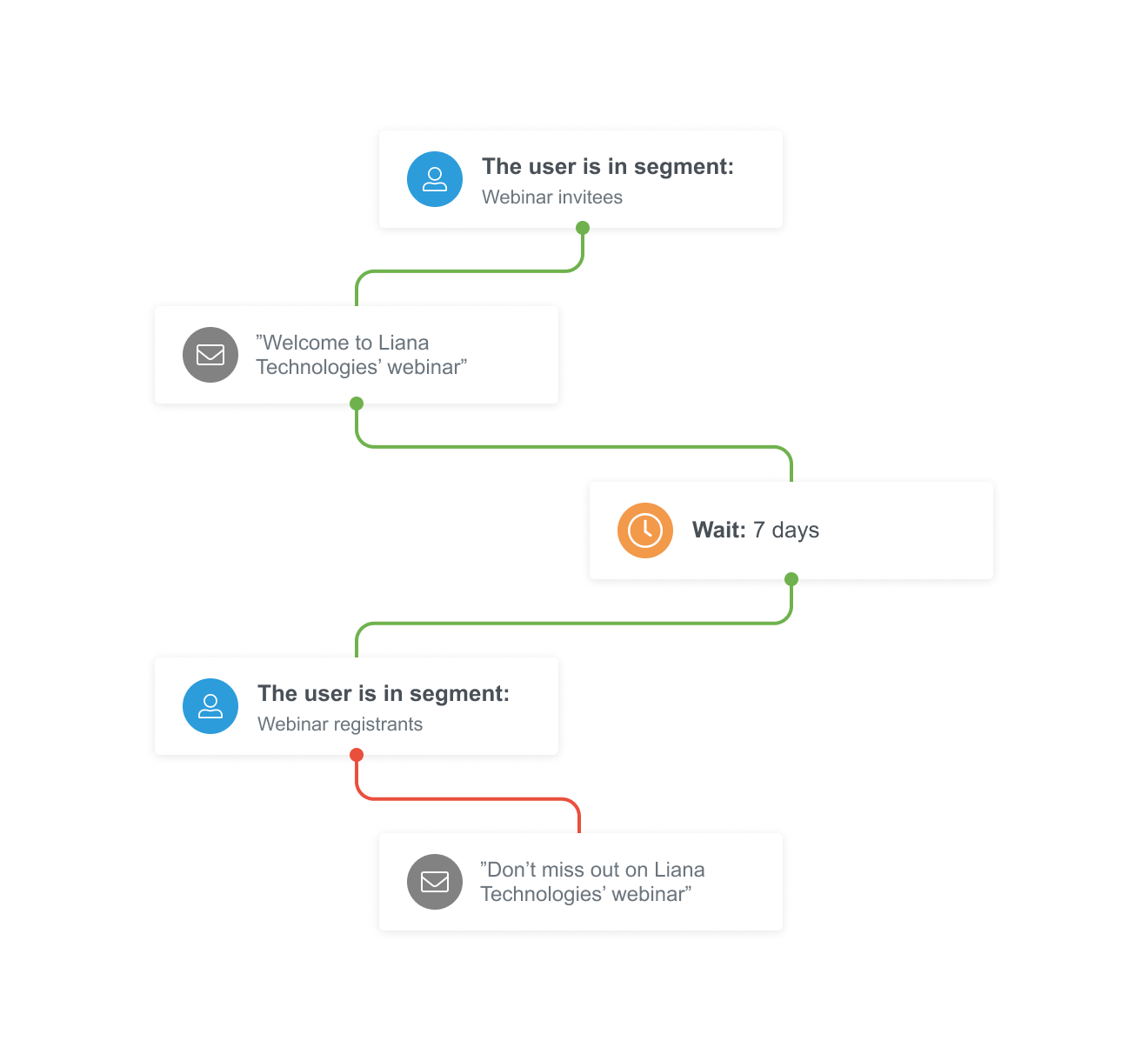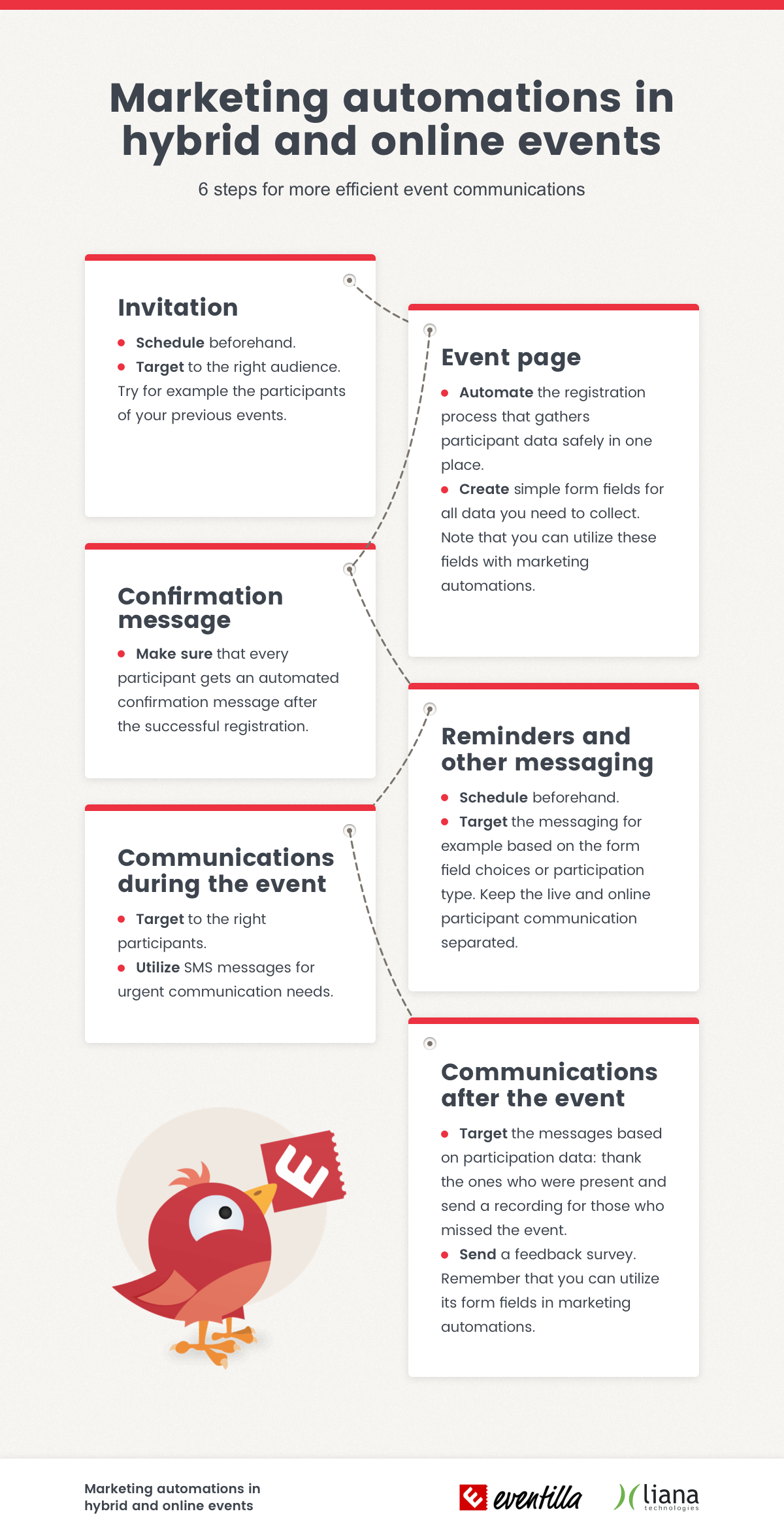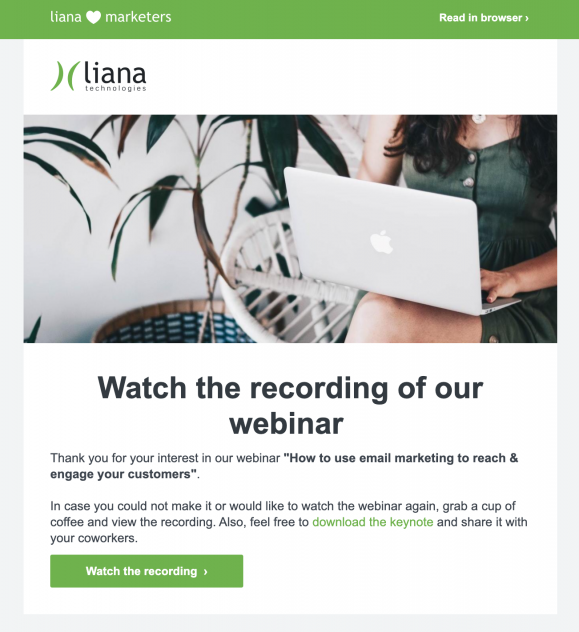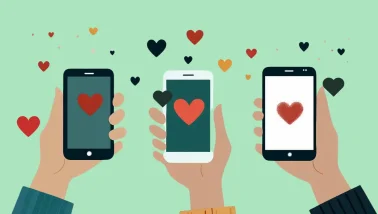Arranging an event takes a lot of work and includes a list of things to remember – whether the occasion is live, online, or as a hybrid, combining both. Especially the needs for communications vary between different event genres. Invitations, tickets, confirmation messages, reminders, and other informative messages – not to even mention marketing – there’s a lot to remember.
That’s why every event organizer’s toolkit should include marketing automation.
Marketing automation helps to target and schedule more efficient event communications. Automations make it possible to schedule messages beforehand and target them to certain audiences based on their participation, behavior, or other data.
This allows the organizer to create automation workflows that make the arrangements easier and more efficient. By using marketing automation, the organizer makes sure that all event data is utilized and visible for the whole organization.
Let’s begin to explore the marketing automation possibilities within event communications. In this article, you’ll find…
- A recap on hybrid and online events
- Tips on how to start planning marketing automation
-
Instructions on how to utilize marketing automation with online and hybrid events
Hybrid and online events
The concept of hybrid events isn’t that familiar to all just yet. At its best, a hybrid event can combine the best of both worlds within online and live events, bringing together a broader and maybe even more international audience.
But how to get there and make sure everything goes smoothly? This is where good event communication steps in. Make sure to communicate in such a way that makes your audience understand the new hybrid event concept and get realistic expectations from it. With hybrid events, it’s especially important to target the messaging based on participation type: the online participants don’t need to hear from live location arrival instructions and the live participants on the other hand don’t get extra value from webinar software advice.
Online events and webinars have entered our lives by the latest during last year. The communications for online events should also be informative. Participants want to know at least the technical requirements of how to follow the event and how to join the fun. Good communications bring added value to the event experience. For example, try handing out some additional materials to support the program.

Planning the marketing automation
You’re probably already familiar with one of the most important principles of marketing: knowing your customer personas. This works as a good starting point for planning the event communications and automation too.
Who are the ideal participants of your event? What media do they use and read? What are their motivations for participating in the event and what use will they get out of it? These are some of the important questions that should stand at the base of your event communications. Here you’ll find more tips for event communications.
After you’ve defined the ideal participant type, you can start to focus on how those persons will end up participating in your event. Have they shown their interest by subscribing to your newsletter or clicking a CTA button? Or have they already taken the beginners’ version of the same course? These are some questions that guide you in finding the base for the audience you’ll want to invite.
And just like that, you’ve now created segments to target the marketing automation messages to.
How to utilize marketing automation in hybrid and online events
Next, we’ll walk you through the six steps of how to utilize marketing automation in hybrid and online event communications:
- Event visibility online
- Invitations and marketing
- Confirmation messages
- Reminders and informative messages
- Communications during the event
- Communications after the event

1. Event visibility online
Digital marketing needs a home base – a landing page that provides more information for the person browsing online. Create your event a landing page with a registration form. The registration form fields should then collect all the needed participant data safely into one place. Instead of collecting many Excel files or trying to keep up with the registrant count in your head, we recommend using event management software. This will also make sure that all the needed data from special diets to preference questions is collected and possible to anonymize when needed.
Tip! When the registration process is integrated with marketing automation, you can utilize the form field answers and choices when targeting automated messages.
This way the participant data collection is automated and you’ll be able to focus on other tasks.
2. Invitations and marketing
As the webinar or hybrid event is held at least partially online, it’s only natural to send the invitations digitally. Sending digital invitations is the easiest with email marketing, newsletter, or marketing automation software. This also allows message automation and targeting.
How to utilize marketing automation when sending out invitations:
- Schedule the invitations beforehand, to be sent a certain time before the event. Depending on the event’s nature, we recommend sending them at least a couple of weeks before. However, sometimes even a save-the-date message that is sent months prior to the event might be needed.
- Target the invitations to the audience of your choice. With the help of data that is fetched to marketing automation, you can target to…
- Participants of all or some of your events
- Earlier participants who have shown interest in the upcoming events by filling out some specific form field when registering
- Those who chose to answer a certain question on your feedback form (try for example: “Are you interested in participating in our events in the future?”)
- Newsletter subscribers
- List of people who downloaded your website materials
- Schedule and target another reminder invite for those who haven’t yet registered by a certain date and time.
3. Confirmation message
When the participants have registered for an event or bought a ticket, they often expect to receive a confirmation message, stating that the registration has been completed successfully.
An event management software like Eventilla usually sends out the confirmation messages automatically via email, right after the registration has been made. You can also allow the participant to edit their own participation information with just one click in the confirmation message.
When it comes to hybrid events, you should always remember to state the participation type in the confirmation message, so that the participant can check whether the ticket is for the online or live event.
4. Reminders and informative messages
Events tend to have many different communication needs, like reminders, informative messages, instructions, or maybe even some inspirational letters. What they all have in common is that it takes time to plan and write the texts and content. Especially in a hurry, it’s easy to make mistakes (we all know the frustration caused by even the smallest typo).
That’s why all event communications should be automated way before prime time. We always recommend planning the event communications cycle as a whole, and well ahead. Consider at least these: What should the participants know before the event? Do they need additional information about the arrangements or should they prepare in some way?
Other useful ideas:
- Especially online events and webinars are easy to forget. Haven’t we all at least once registered for a webinar, only to notice to have forgotten it the next day… That’s why it’s good to offer a calendar link, so the participants can add the event and reminders to their own calendars. We also recommend sending a reminder message at least 15 minutes before the event. This reminder should include the webinar link and instructions on how to join.
- Hybrid event communications should always be targeted based on the participation type. Live event participants will most likely want to know the arrival instructions at least one day before, online participants on the other hand are usually happy with receiving the webinar stream links on the event day. Here you’ll find more tips for hybrid event communications.
- You can also target automated reminder and information messaging based on the registration form field choices. For example, try sending out recommendations about accommodation options nearby to those who chose “I need accommodation at the venue” when registering.
5. Communications during the event
Sometimes it’s necessary to communicate to the audience also during the event. If the messaging need is urgent, we recommend choosing SMS, because it usually reaches the receiver a bit faster than email.
You can also schedule marketing automation messages during the event, for both email and SMS. Try for example sending the participants additional materials about the event program in PDF form or reminding them about the upcoming speakers. When you’ve scheduled the messages to be sent at the right time, you’ll be able to focus on other arrangements yourself.
6. Communications after the event
You shouldn’t forget the participants even after the event. After all, they gave you some of their valuable time by choosing to attend your event.
Communications after the event is usually wise to target based on the participation data – meaning if the participant actually joined the webinar or came to the venue, or if they missed it entirely.
Those who were present should receive a thank you note, and most importantly a feedback survey. When planning the survey, it’s good to remember that even those feedback survey form fields can be used with targeting marketing automation in the future. Would you like to ask the ones who gave poor feedback about their reasonings or development suggestions later on? Or target your next event’s marketing for those who said they were interested to participate in the future too? You can also set up an alert from very poor feedback, giving you a chance to notice it and react in time.
However, you shouldn’t forget those who registered but never showed up at the event. Especially online events and webinars are often followed up with an event recording, and that’s why many also expect to get the recording afterwards by only registering. And when it comes to future events, this audience is also a delicious one to target to.

But how to get the participation data to a marketing automation software? Webinar integration with an event management software makes it possible to follow participation data and this way also target the messages based on the participant’s presence. Hybrid event live participation on the other hand can be tracked for example by scanning QR-coded tickets.
Efficient event management with Eventilla
Eventilla is an event management tool that makes it possible to create brand-like landing pages, registration processes, reports, communications, and surveys. The event process is always designed to follow the event organizer’s own brand, which makes the event a seamless part of other marketing activities. Eventilla suits well for both hybrid and online events, because it allows targeting messages and versatile integrations.
Eventilla integrates with Liana®Cloud tools such as Liana®Cloud Marketing Automation and can be used in the same UI.
Interested to know more about efficient event communications and event management? Ask us for more information or a demo presentation of the tool.



